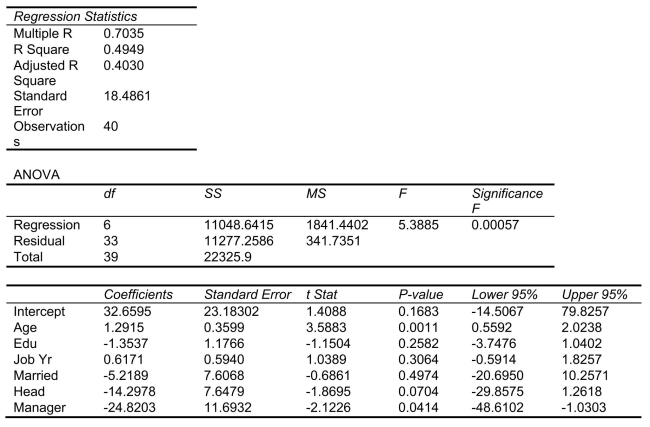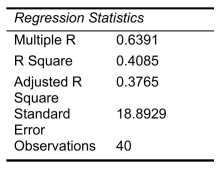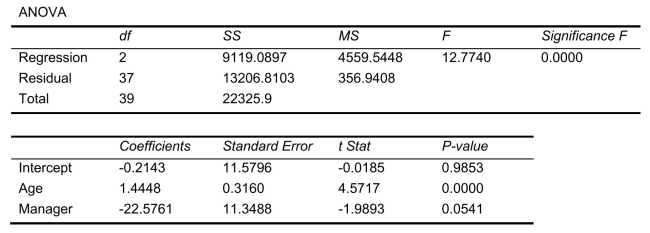SCENARIO 18-10 Given below are results from the regression analysis where the dependent variable is the number of weeks a worker is unemployed due to a layoff (Unemploy)and the independent variables are the age of the worker (Age), the number of years of education received (Edu), the number of years at the previous job (Job Yr), a dummy variable for marital status (Married: 1 = married, 0 = otherwise), a dummy variable for head of household (Head: 1 = yes, 0 = no)and a dummy variable for management position (Manager: 1 = yes, 0 = no).We shall call this Model 1.The coefficient of partial determination  of each of the 6 predictors are, respectively, 0.2807, 0.0386, 0.0317, 0.0141, 0.0958, and 0.1201.
of each of the 6 predictors are, respectively, 0.2807, 0.0386, 0.0317, 0.0141, 0.0958, and 0.1201.  Model 2 is the regression analysis where the dependent variable is Unemploy and the independent variables are Age and Manager.The results of the regression analysis are given below:
Model 2 is the regression analysis where the dependent variable is Unemploy and the independent variables are Age and Manager.The results of the regression analysis are given below: 

-Referring to Scenario 18-10 Model 1, the alternative hypothesis  : At least one of
: At least one of  for j = 1, 2, 3, 4, 5, 6 implies that the number of weeks a worker is unemployed due to a layoff is affected by all of the explanatory variables.
for j = 1, 2, 3, 4, 5, 6 implies that the number of weeks a worker is unemployed due to a layoff is affected by all of the explanatory variables.
Definitions:
Withdrawals
Withdrawals refer to the act of taking out cash or assets from a business by its owners for personal use, impacting the owner's equity.
Capital balances
The amount of money that partners or owners have invested in a business minus any withdrawals they have made from the business.
Profits
The financial gain obtained when revenues generated from business activities exceed the expenses, costs, and taxes needed to sustain those activities.
Losses
Financial conditions reflecting that expenses have exceeded revenues, resulting in a negative net income.
Q17: Referring to Scenario 20-4, what is the
Q65: Referring to Scenario 18-8, what is the
Q76: Referring to Scenario 19-4, what is the
Q93: Referring to Scenario 20-5, what is the
Q97: Referring to Scenario 19-9, an R chart
Q137: Referring to Scenario 19-3, suppose the analyst
Q158: Suppose students arrive at an advising office
Q233: Referring to Scenario 18-9, _ of the
Q236: Referring to Scenario 18-9, which of the
Q252: Referring to Scenario 18-1, when the builder